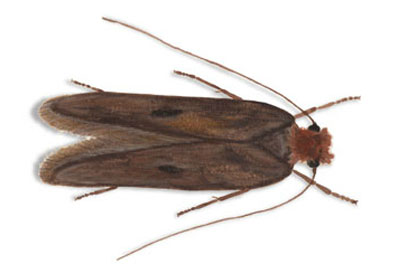


Clothes Moth Diet
Fabric moths tend to target clothing stores, museums, and coat closets, attics, and furniture in homes to feed on wool clothes, natural carpets, furs, stored wool, and piano felts. Case-making clothes moths will also feed on stored plant materials, such as spices and tobacco.
Clothes Moth Habitat
Casemaking clothes moth
Usually protected in a case made of silk and fibers of feeding material.
Webbing clothes moth
Often found in a network of silken tubing. Larvae may be difficult to spot as they hide in a network of silken tubing.

Casemaking Clothes Moth Life Cycle
The female deposits 37-48 eggs singly or in small groups. Hatching occurs in four to seven days. Caterpillar development is complete in 68-87 days, and pupation takes place in the larval feeding case after both ends are sealed. The life cycle is completed within three to eight months, and there are three to four generations per year.

Webbing Clothes Moth Life Cycle
The female lays 40-100 eggs in her lifetime in batches of about 25. Eggs are deposited singly or in batches between threads on cloth surfaces. Hatching occurs in about seven days. Caterpillar development includes 5-45 stages (molts) and can last from 35 days to 2.5 years. Caterpillars make cocoons for pupation. Males live 13-79 days; females 10-48 days. The entire life cycle completion usually takes three to eight months.
Signs of a Clothes Moth Infestation
One of the first signs of a clothes moth infestation is likely to be the telltale holes in clothing, wool carpets, curtains, and furniture. That’s because moths like to lay their eggs in places where the larva will hatch and then devour fabric such as clothing, upholstery, carpeting, and other fabrics. The adult moths do not eat fabric and clothing, but they will reproduce and create more larvae that will.
While the first thing most people notice is the damage caused to clothes, fabrics, or carpets, there are other indicators of a moth infestation:
- Small maggot-like larvae (moth caterpillars)
- Silken tubes or cases in which the moth larvae live
- Pupae (silk cocoons) from which larvae emerge as moths
- Adult moths often crawling rather than flying
- Insect debris (droppings and/or silk threads) around the damaged area
Clothes Moth Damage
Fabric pests are usually attracted to natural fabric items such as carpets, tapestries, rugs, leather book bindings, upholstered furniture, silks, and feathered items. Case-making clothes moths do extensive damage to woolens, felts, upholstered furniture, and clothes. Webbing clothes moths damage a variety of animal products, including wool, fur, skins, clothing, carpets, upholstered furniture, and felt.
Rugs
The most common item that gets damaged by fabric pests is wool rugs. As woolen rugs can be expensive, it is strongly recommended you check them frequently for signs of fabric pests.
Woolen Products
In general, untreated woolens stored unprotected in cupboards for several months are more prone to insect damage. Wool textiles infrequent use and regularly washed or dry cleaned are unlikely to suffer damage from fabric pests unless infestations occur nearby.
Knitted Goods
Insect damage to fabrics and fine knitted goods usually takes the form of irregularly shaped holes where yarns have been completely severed and eaten, much like the damage small caterpillars can do to the leaves of plants.
Other Items at Risk
Other items include pillows, mattresses, cushions, and furniture with traditional fillings such as feathers or horsehair. Brushes and paint brushes made with natural bristles and pads and felts in woodwind instruments (especially if stored for long periods of time) may also be found with damage.
Clothes Moth Prevention & Control
Clothes Moth Prevention
To reduce the risks of a clothes moth infestation, follow the steps below:
- Depending on the species, simply vacuuming regularly can make the home environment unsuitable for the pests.
- Promptly launder all clothes and fabrics stained with food products or bodily fluids.
- Additionally, storage bins containing products that moths like to feed on should be carefully cleaned between uses.
Clothes Moth Control
We can help you with our full range of effective solutions to treat infestations and eliminate your moth problem. Our effective treatment is suitable for eliminating moths, eggs, and larvae in delicate items that cannot be laundered.
Prior to recommending a moth control solution, your specialist will properly identify the species affecting your property. Correctly identifying the invading species is key to removal. Different moth pest species require different treatment methods to effectively control them. For the fabric moth pests, vacuuming, sanitation, proper storage, liquid sprays, and dust are commonly used.
- In the case of fabric moths, dry cleaning the affected garments may effectively kill adults, larvae, and eggs.
- Where possible, regularly washing fabric items and carefully storing clothes, will also help to keep your items safe from damage.
- Extreme cold or heat kills any moth species, so freezing or heating food items to do away with stored product moths remains an option.
- Non-chemical solutions include the simple act of vacuuming. This plays an important role in removing cast skins and eggs, which helps to break the natural life cycle of fabric pests and reduce their population on your property. Ensure your vacuum upholstered furniture and underneath items of furniture, not just carpets, and rugs. Carpet edges next to skirting boards and pet bedding should also be carefully vacuumed. It is important to immediately discard the content of your vacuum cleaner outside of your property.
- If you intend to store clothing for a long time, you should ensure all items have been washed and are clean. Wrap up items in plastic to keep them safe from fabric pests.
Monitoring using various traps including pheromone traps where applicable is done thereafter to ensure moth problems do not persist.
For unusually persistent infestations of moths, count on a professional pest management service to take care of the problem knowledgeably and successfully.
Need help with Clothes Moths?
We'll call you! Leave your information below.



